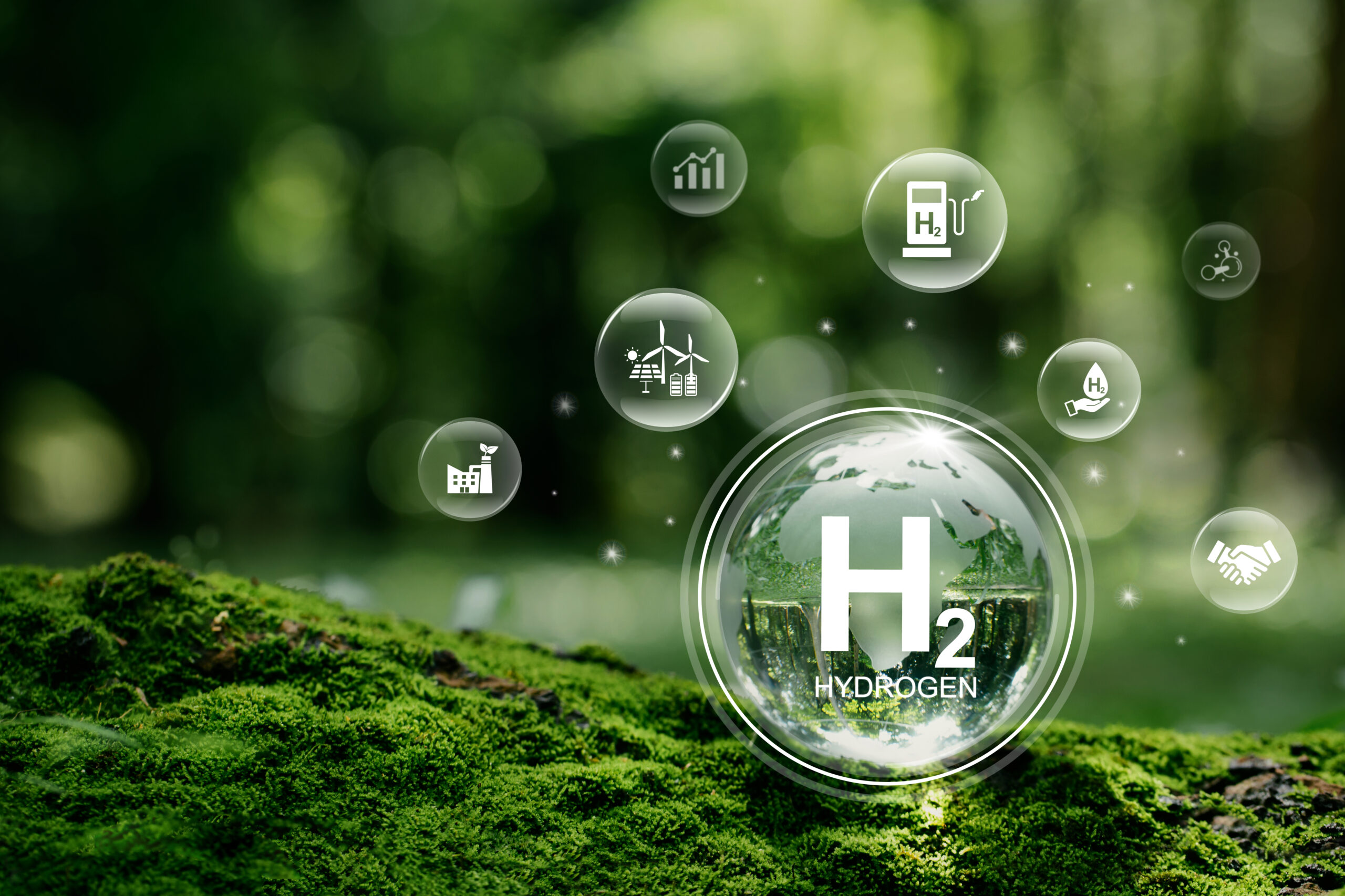
has never been greater
we need to get to zero-carbon today

has never been greater
transition while maintaining and creating
high-quality, family-sustaining jobs

has never been greater
on fossil fuels, achieve energy independence,
and create an affordable clean energy future
Stay in the loop for green hydrogen news
What is Green Hydrogen?
Hydrogen has been safely used for decades in industrial applications such as semiconductor manufacturing, fertilizer production and oil refining, with over 94 million tonnes consumed each year around the world. To date, the vast majority of hydrogen used in industrial applications has been produced from fossil fuels. Today, green hydrogen can be made from renewable resources like wind, solar, and biomass and can replace fossil fuels in some of the heaviest polluting and hardest-to-electrify sectors, such as:
![]()
Trucking
![]()
Shipping
![]()
Aviation
![]()
Manufacturing
![]()
Agriculture
![]()
Power
Unlocking A Cleaner Future for Ports with Green Hydrogen
The combined ports of Los Angeles and Long Beach make up the single largest fixed source of air pollution in Southern California, according to the South Coast Air Quality Management District. Fenix Marine Services, the second largest port operator in the ports, has been working to reduce their dependence on diesel by adopting hydrogen fuel cell technologies. Watch the video below to hear from the employees who are working with this innovative equipment
Green Hydrogen’s Role to Reduce Emissions in the Port of LA and Long Beach
Hydrogen Around the World
Explore how countries, states, and cities around the world are safely utilizing hydrogen today, and discovering innovative green and clean hydrogen projects that will accelerate the global clean energy transition.
Green hydrogen can be produced, transported, and used affordably and safely today

Produce
Hydrogen is the most abundant element in the universe, but in nature, it always appears bonded with something else; for example, water (H2O) is composed of hydrogen and oxygen. An energy input is needed to separate hydrogen from the naturally occurring element to which it is bonded. This is done commercially and at very large scale all over the world today, primarily by separating hydrogen atoms from carbon atoms in natural gas (CH4). Green or renewable hydrogen can be made by liberating hydrogen naturally present in water or organic waste, utilizing renewable energy. For example, renewable electricity from wind and solar can be used to split water molecules into hydrogen and oxygen (a process called electrolysis), producing zero-carbon green hydrogen.

Store and Transport
On a local level, hydrogen is often stored within tanks or containers as a compressed gas or liquid. On a larger scale, hydrogen can be stored underground in geologic salt caverns (three commercial salt caverns are already operating to store hydrogen in the United States). Pipelines are the most cost-effective solution to transport large volumes of hydrogen, especially where large end users are densely clustered. Hydrogen transport via pipeline has been commercially used for decades, with more than 1,600 miles of dedicated hydrogen pipeline in commercial operation (including ~17 miles of pipeline in Los Angeles). Today, hydrogen is commonly transported to end users such as public fueling stations by trucks.
Use
Green hydrogen can also directly replace fossil fuel use for many sectors. A few examples:
- Where hydrogen is currently used in industrial processes, such as fertilizer production, green hydrogen can simply be swapped for the fossil fuel-derived hydrogen already used today
- In some applications, such as the power sector, green hydrogen can be utilized by existing infrastructure as a direct replacement for natural gas
- Hydrogen fuel cells are commercially available to utilize in hard-to-electrify mobility applications such as long-distance trucks and indoor forklifts. Fuel cells can also be utilized for backup power to replace diesel generators
- Technology is rapidly evolving for green hydrogen to be utilized in place of fossil fuels in many difficult to decarbonize sectors, such as aviation, transoceanic maritime shipping, and more.
Hydrogen is already a viable clean alternative to many existing uses of fossil fuels. As production reaches scale and costs decline, it will increasingly reduce our dependence on fossil fuels
- 1. Air Quality Improvements
- 2. Reliable, Affordable, and Safe Clean Energy
- 3. Economic Growth & Job Creation
![]()
Tailpipe emissions from burning gasoline and diesel fuel are the most significant sources of air pollutants (particulate matter, nitrogen oxides, and volatile organic compounds) in the United States. Green hydrogen can replace fossil fuels in hard-to-electrify mobility applications, leading to significant air quality and public health improvements.
![]()
Wind and solar are the low-cost sources of renewable electricity and are being widely deployed to help decarbonize the electrical grid. However, studies across multiple states have demonstrated the need for resources that power the grid when the sun is not shining, and the wind is not blowing. Production of green hydrogen creates the opportunity to capture wind and solar and store it for weeks, months, and even seasons to be used when needed. This will allow for faster integration of renewable electricity resources and a more reliable grid to support electrification.
![]()
Studies find that establishing a green hydrogen economy will create hundreds of thousands of diversely skilled, family-sustaining jobs across the country. Many of these jobs can utilize similar skillsets to existing energy industry jobs, creating strong opportunities for fossil fuel workers to transition and participate in the clean energy future.
These organizations agree: GH2 is an essential tool to achieve deep decarbonization and end our dependence on fossil fuels.





Get Involved in the Clean Energy Transition
Take Action
Make a direct impact by contributing to the only 501(c)(3) educational nonprofit focused on advancing green hydrogen. All proceeds are 100% given to various educational and market development initiatives.
Stay Updated
Sign up for the monthly newsletter to get the latest on green hydrogen developments.
Learn More
Learn more about the Green Hydrogen Coalition and access free resources.
More Resources
Green Hydrogen News
Accelerating South Australia’s Clean Energy Transition with Green Hydrogen-Powered Aeroderivative Gas Turbines
Accelerating South Australia’s Clean Energy Transition with Green Hydrogen-Powered Aeroderivative Gas Turbines GE Vernova has unveiled the LM6000VELOX, a...
Recent Electrolysis Developments: Reducing the Cost of Green Hydrogen Production
Electrolysis is the method of splitting water into hydrogen and oxygen using electricity. When powered by renewables, such as wind and solar, it offers one pathway to producing green hydrogen with...
Denmark’s Leading Aviation Companies Join Green Hydrogen Sustainable Aviation Fuel Project
Scandinavian Airlines System (SAS), Copenhagen Airport, Aalborg Airport, and Copenhagen Infrastructure Partners (CIP) have signed a collaborative agreement to produce green hydrogen-based synthetic...
Biden-Harris Administration Announces First Grants for Hydrogen Hubs in Texas and the Midwest
The U.S. Department of Energy (DOE) has approved the first grants to launch two additional hydrogen hubs (H2Hubs): the Gulf Coast H2Hub, led by HyVelocity in Texas, and the Midwest H2Hub, led by the...
SoCalGas, GKN Hydrogen, and NREL Launch Solid-State Hydrogen Storage Demonstration Project
Southern California Gas Co. (SoCalGas), GKN Hydrogen, and the U.S. Department of Energy's (DOE) National Renewable Energy Laboratory (NREL) have partnered to...
Hawaii to Receive $59M in Federal Funding for Hydrogen Fueling Station
Hawaii has been awarded $59.2 million in federal funding from the U.S. Environmental Protection Agency to support climate adaptation and reduce emissions at its ports. This funding, as part of the...
Donate
Your donation enables faster progress towards a green hydrogen economy
Accelerate the production and use of
green hydrogen at scale
Speed up decarbonization across
various sectors
Want to learn more?
Check out some of the following resources below!












